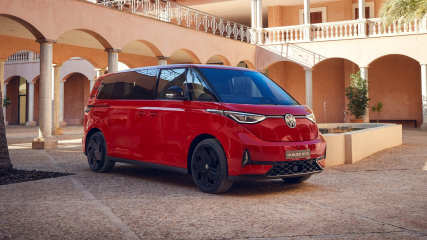Five best cheap luxury cars in Australia
By David Morley · 30 May 2024
Maybe you’ve heard the expression “There’s no such thing as a cheap luxury car”.The fact is, there’s at least some truth to it, because by their very definition, a luxury car costs more than its more prosaic counterpart.Maybe affordable luxury cars is a better description. Or even low-priced luxury cars or budget luxury cars.And if that’s the case, what else makes a car a luxury car? And, by default, what is a cheap luxury car?A lot of people start with the badge the thing wears. Just as there are luxury clothing brands and luxury furniture manufacturers, so too does the automotive industry contain luxury or prestige brands.But even a more mass-market carmaker can include a luxury line-up at the top of its range, so clearly that’s not the only criterion.Typically, luxury cars are the first to market with the latest tech and safety features. That’s purely because they have a higher profit margin for their manufacturers, so they can still be sold profitably even though they cost a lot more to make.Luxury cars, traditionally, have also stood apart form the sports car tag although, lately, those lines are becoming increasingly blurred as powertrain technology (EVs, mainly) offer up mind-blowing performance even in a big, heavy luxury car.Certainly, though, having ample performance has always been important for any luxury car.So, having made the leap that your next wheels will be a prestige make or model (or both), what’s the best way to get luxury cars for cheap?Without a doubt, the answer is to shop second-hand. There are several really sound reasons for this.The first is that cars get cheaper as they age and rack up kilometres. And it doesn’t matter how luxurious a model once was, if it’s now an older car with 200,000km on its odometer, we can guarantee it will change hands for a fraction of its new cost.Yes, there are the odd exceptions, but those surround cars that are, for whatever reason, considered collectible or super rare.The second reason is that luxury cars just tend to be better built in the first place, and, therefore, better equipped to handle those years and kilometres.So they’ll often age a bit more gracefully than their cheaper counterparts which were originally built down to a price.Thirdly, there’s what’s called the funnel effect. This is when there are enough high-fliers and executives to buy a batch of high-end cars brand-new, but not enough private buyers willing to shell out when those cars hit the market at the end of their lease term.That’s when you’ll see the laws of supply and demand in action. Less demand means lower prices, and suddenly, you’re buying a car that was super-expensive just three years ago, at a bargain price.Okay, so why not a luxury car for your next ride?This is another reason luxury cars are often second-hand bargains; people are scared of them. They’re frightened of the price of parts and repairs for high-tech, often imported cars where there’s a lot more to go wrong in the first place. The luxury car price tag could just be the beginning of the spending if you get the wrong one.This is a real concern, too, and anybody who has received a repair estimate that’s more than the car is worth will know the feeling.Fortunately, there are plenty of independent repairers out there who specialise in one luxury brand or another and will usually be a cheaper option than dealership servicing and repairs.You might also find insurance will cost more on a luxury car as the underwriter hedges their bets a little.And as with anything imported right now, supply chain hassles might mean a wait on parts from overseas.So how about a list of the cars we reckon are going to make the best budget-beating luxos?We’ll stick to best luxury car under $50K. but we’ll also throw in a couple of real speculators that represent the best cheap luxury cars under $10K, which, if nothing else, should start a few debates.As for where to search, well, the online classifieds like Autotrader or CarsGuide are a great place to find cheap luxury cars for sale.Price: From $19,000This model 7 Series was a victim of its own controversial styling. The odd bootline and upside-down face kept some buyers away and while that didn’t matter too much to captains of industry buying them brand-new, it meant they sat around as used cars.There were six-, eight- and 12-cylinder engines offered, but the V8 is probably the nicest. The V12 is glorious but will bankrupt you if it goes wrong. But this is a great example of one of those cheap cars that looks expensive.Watch out for: Cars with broken adjustable suspension, high-miles (some were hotel limos) tatty interiors and worn transmissions.Price: From $12,000When it comes to the best cheap luxury cars Australia is often overlooked as a source. But the later Caprice models were proper luxos with loads of equipment and good (if not brilliant) build quality. And as one of the cheapest luxury cars to maintain, Australia does it again.The best buy is the V8 which better suited the role of hauling a big car across a big country in style. The V6 was definitely the poor relation and often saw taxi duty thanks to the availability of an LPG option from the factory.Watch out for: Really tired mechanicals, worn camshafts and lifters, sagging headlining, glitchy electronics.Price: From $25,000The original Lexus LS400 rewrote the book on luxury cars and gave the established players a huge fright. But those still around have often been to the moon and back (because they will) so a newer LS model looks like good buying.There was a great V8 petrol engine and even a hybrid version, but which ever way you go, you’ll be buying a superbly quiet cabin and impeccable build quality. Not the sportiest cars ever made, these are nevertheless 100 per cent Quality Street.Don’t be worried about the Toyota connection, either. Many Japanese and Korean brands have tried an upper-shelf luxury branding exercise (Mazda, Nissan and Hyundai to name just three) but Toyota pulled it off best with Lexus.Watch out for: High miles, sticky dashboards, incomplete service record.Price: From $4000No discussion of classy cheap cars can ignore the W124 Mercedes. When new, they cost about the same as a house, but now – thanks to age and fear of repair costs – they’re almost free to a good home.Not many people associate Mercedes-Benz with the cheap luxury car brands, but in this case, it’s entirely justified.Grab a six-cylinder version as performance and refinement are better than the four-cylinder, and be amazed at how well something this old drives and how brilliantly the interior has held up. This could be the best value luxury car ever.Watch out for: Blown head gaskets, insane mileages, glitchy ABS.Price: From $9000At a time when Volvo was casting off the bowls-hat image and getting semi sexy, the C70 arrived in hardtop and soft-top form.Power came from a five-cylinder turbocharged engine with a hot-rod version if you wanted to go faster. A four-speed automatic was most commonly fitted, but that was replaced by a five-speed auto in 2001, so that later car is the one to find now.Solidly built and decent to drive, they also somehow exude a bit of classiness that isn’t evident in all Volvos. There’s plenty of leather and standard equipment and the looks have aged pretty well. The ride is slightly firm, though, which was a Volvo thing at that time.Watch out for: Trashed gearboxes, rattly suspension, split cylinder bores (on the hotter, T5 model).

.jpg)
.jpg)





.jpg)
.jpg)
.jpg)